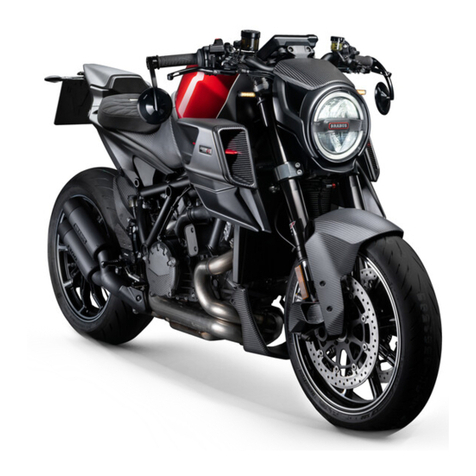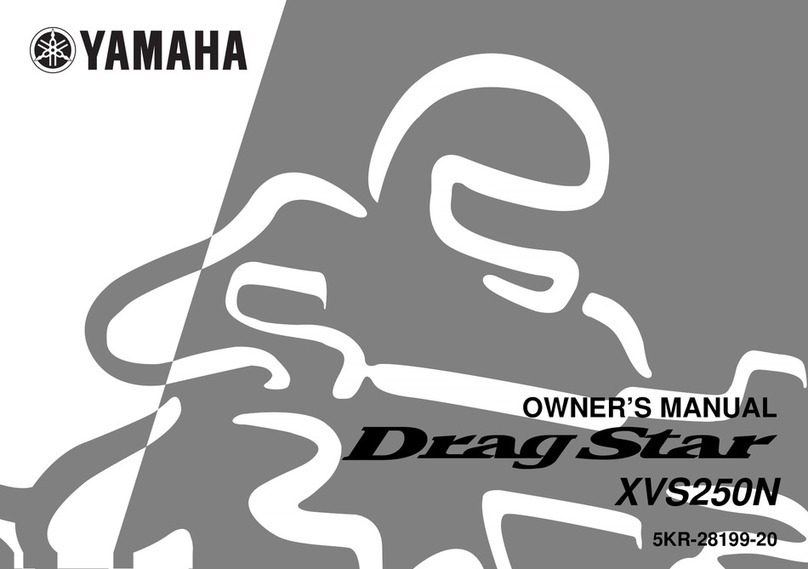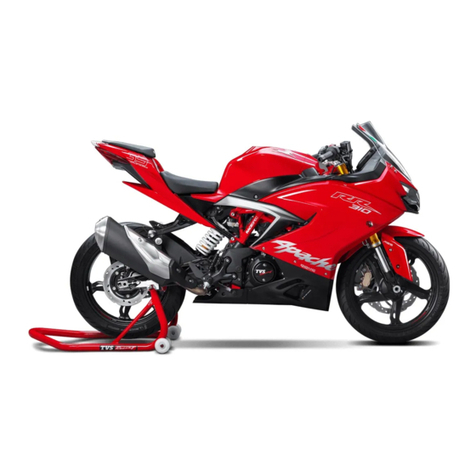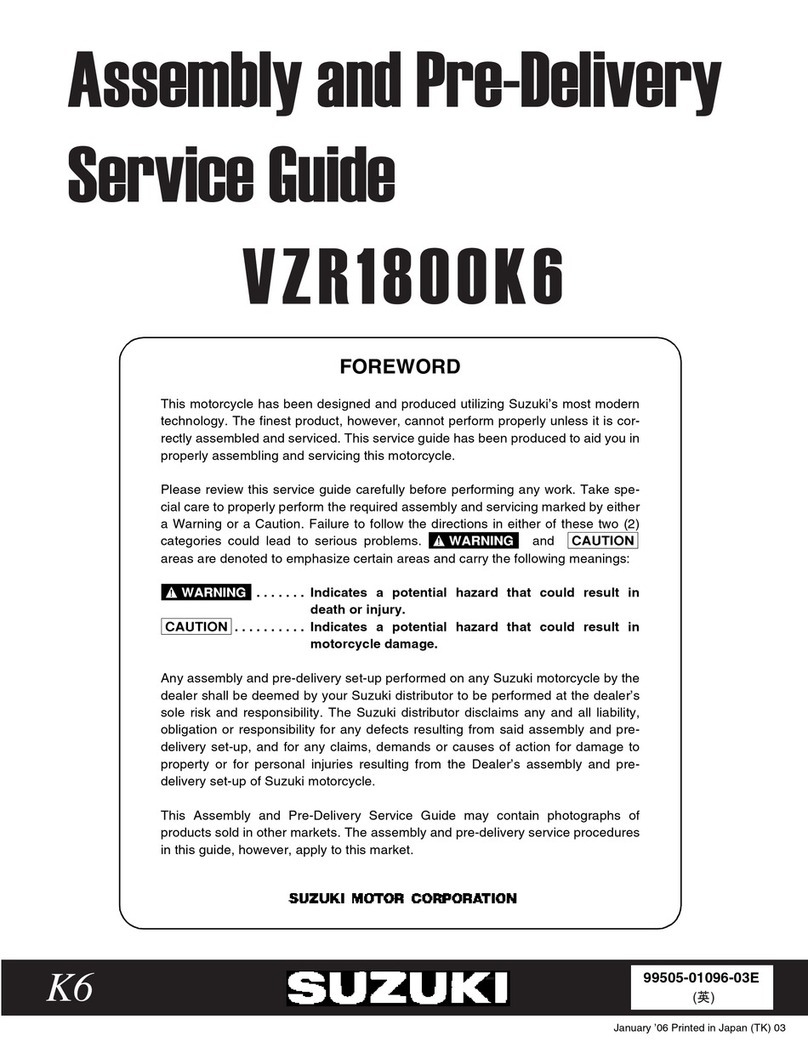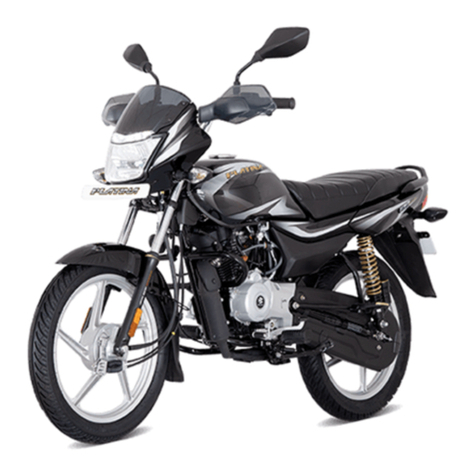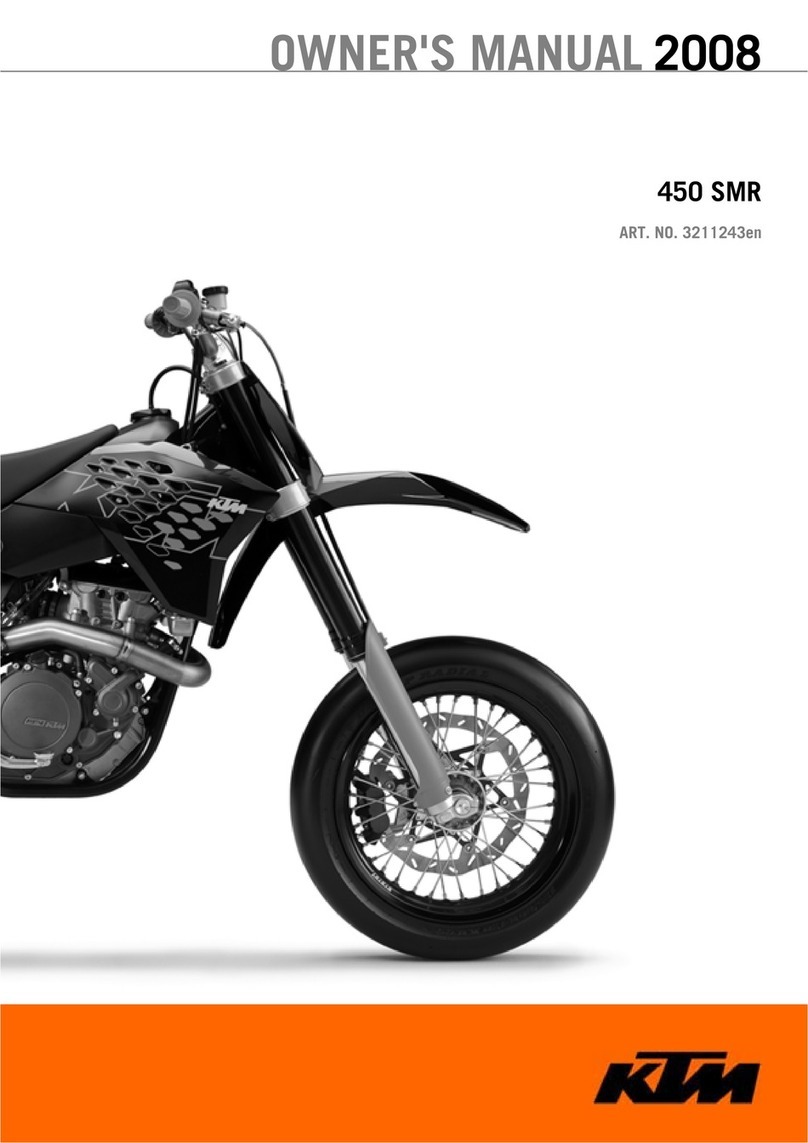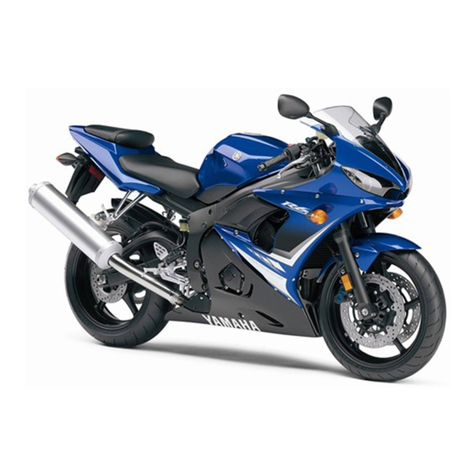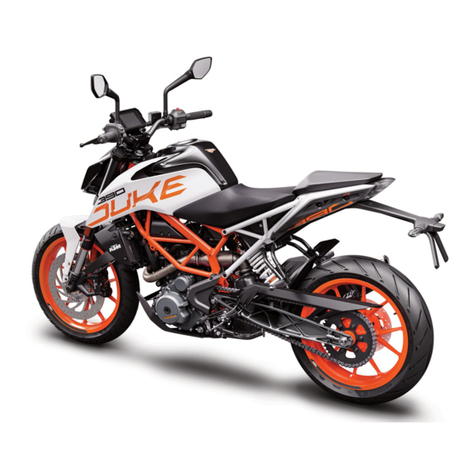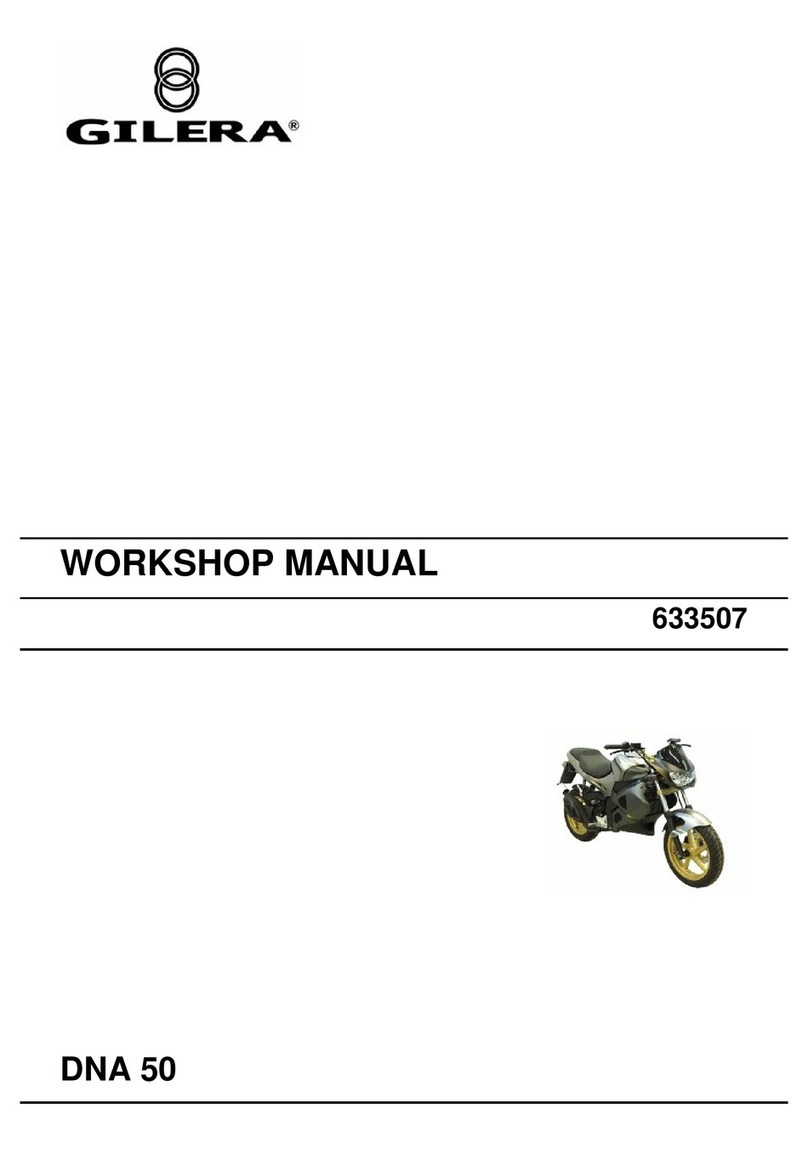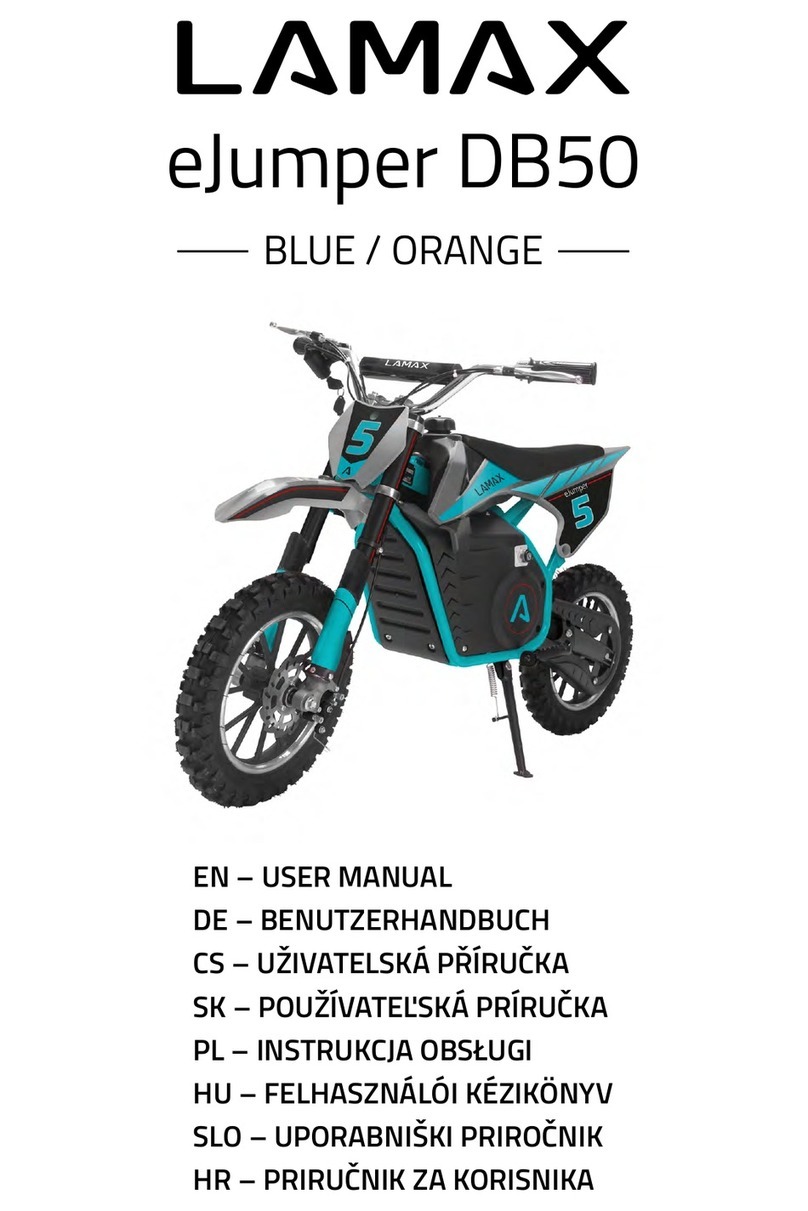Blata Origami B1 User manual


Noise emitted by machinery and equipment (Minibike BLATA ORIGAMI B1) - Measurement of emission sound pressure levels at a work
station and at other specified positions. Levels measured by authorized person ( TUV CZ s.r.o.). Test record (no. : 816/90/06/BT/IZ/H) is
deposited with producer.
RPM Average level of the acoustic pressure A at
a work station (ČSN EN ISO 11202)
Total average level of the acoustic power
(ČSN EN ISO 3744)
2600 rpm (idling speed) LAeq = 85.3 dB LWA [dB (A)] = 89,2 dB
11 000 rpm LAeq = 107,5 dB LWA [dB (A)] = 115,3 dB

SAFETY WARNING
Always pay attention to the instructions and safety warnings below
This manual contains important safety information and instructions which should be read
carefully before operating the vehicle. For your own safety and the safety of others follow
these rules.
Neither manufacturer nor distributor is responsible for injuries caused by unsafe and improper
use of the vehicle.
This vehicle is not allowed to be used on public roads!
Unsafe and careless use of the vehicle can result in serious injuries. The driver can
minimize the potential risks by wearing safety equipment. The driver must wear a
safety helmet, goggles, gloves, elbow pads, kneepads, and firm footwear. Avoid rough
surfaces and obstacles. Always drive with both hands on the handlebars.
Fuel and fuel vapour are highly toxic and flamable. Always be careful when handling
fuel – it can burn or poison you.
- stop the engine and turn off the fuel tap, keep naked flames and sparks away from
your bike.
- do not smoke near your bike.
- refuel only outdoors in a well ventilated space
- clean up any excess fuel immediately
- keep children and pets away
Always ride within the limits of vehicle/ rider and weather conditions to avoid
unnecessary accidents and injuries.
Check-ups
Shut the engine off when performing maintenance check-ups otherwise You could be
severely injured if your hands or clothing get caught by moving parts.
Make sure the engine and exhaust are cold before performing any inspection of this
machine
Riding with a chain in poor condition or improperly adjusted can lead to serious injury.
Always, Inspect, Adjust and Maintain the drive chain properly before each ride.
Failure to inspect and properly maintain the brakes increases the risk of having an
accident. Before each ride check the brake cables and the brakes efficiency.
Riding with worn brake pads can reduce the braking performance and cause an
accident. Check and replace brake pads according to the instructions in this manual.
Using worn, improperly inflated, or incorrect tyres will reduce stability and can cause
an accident.
DISPOSAL OF UNUSABLE PRODUCT
Unusable product become a waste and it’s desposal should be in accordance with
the law and any applicable local regulations. Don’t throw this product to municipal
waste.
Always inspect the bike before each ride (refer to the article ‘INSPECTION AND
MAINTENANCE’). Failure to inspect and maintain your bike properly increases the risk
of an accident or damage to the vehicle.

SERVICE MANUAL FOR USE AND MAINTENANCE AND SPARE PARTS LIST
For your own safety and the safety of others Follow these recommendations in order to use
your MINIBIKE safely and correctly. Read the instructions CAREFULLY, failure to do so may
place yourself and others in extreme and or ultimate DANGER. If you do not understand the
instructions and Data then, you are not to attempt to operate this Minibike under any
circumstances. It may be used for show purposes only!
CONTENTS
PAGE
INTRODUCTION ............................................................................................................................................2
TECHNICAL DATA........................................................................................................................................2
UNPACKING AND SETTING UP BEFORE RIDING - FIG. 1 ........................................................................3
SAFETY .........................................................................................................................................................3
BEFORE STARTING .....................................................................................................................................3
STARTING THE ENGINE - FIG. 2 .................................................................................................................4
CARBURETOR - FIG. 3.................................................................................................................................4
RIDING ..........................................................................................................................................................4
PERIODIC MAINTENANCE...........................................................................................................................5
CHAIN SETTING AND MAINTENANCE ......................................................................................................5
CENTRIFUGAL CLUTCH REPAIR OR REPLACEMENT .............................................................................5
BRAKES ADJUSTING - FIG. 4......................................................................................................................6
FRONT BRAKES PADS REPLACEMENT....................................................................................................6
REAR BRAKES PADS REPLACEMENT .....................................................................................................6
REMOVE AND REFIT THE FRONT WHEEL ................................................................................................7
REMOVE AND REFIT THE REAR WHEEL .................................................................................................7
REPLACEMENT OF SPROCKET - FIG. 9 ...................................................................................................7
FRONT AND REAR WHEEL – FIG. 10 .........................................................................................................8
FRAME – FIG. 11...........................................................................................................................................9
GLASS BODY COMPLETE – FIG. 12 ...........................................................................................................10
MINIBIKE ORIGAMI B1 - FIG. 5 ...................................................................................................................11,12
ENGINE - BLATA – FIG. 15 .........................................................................................................................13
EXHAUST COMPLETE – FIG. 13..................................................................................................................14
FRONT FORK – FIG. 14 ................................................................................................................................15
FRONT AND REAR BRAKES - FIG. 7 ........................................................................................................16
PARTS LIST...................................................................................................................................................17,18
CLUTCH COMPLETE – FIG.6 ......................................................................................................................19
REPLACEMENT OF CLUTCH – FIG. 16.......................................................................................................19
REPLACEMENT OF TIRE ............................................................................................................................20
DISMANTLING OF AIR FILTER ...................................................................................................................20
CLUTCH ADJUSTMENT – FIG. 8 .................................................................................................................20
MAINTENANCE OF COOLING SYSTEM…………………………………………………………………………..21
TORQUE SETTINGS ....................................................................................................................................22
STORAGE PROCEDURES............................................................................................................................23
GUARANTEE LIST …………………………………………………………………………………………………... 24
1

INTRODUCTION
The Minibike Origami B1 is designed and built for use on a paved closed circuit
track. The track should be clean and without obstacles of any kind. Qualified
adults and younger persons can drive the minibike. Children can drive the
minibike only under the supervision of a responsible adult person. The
minibike is constructed especially for racing competitions on special racing
tracks. Minibike Blata should not be used during winter season and under bad
weather conditions. Usage under these conditions leads to abnormal
mechanical wear and corrosion of most minibike parts - especially those
directly exposed to climatic influences. Beside that, riding under these
conditions increase the risk of injury or health damage.
The minibike uses a single-cylinder two-stroke, Gasoline combustion engine,
and has an air filter and exhaust silencer. Transfer of power to the rear wheel is
through a drive chain. The overall drive ratio to the rear wheel can be changed
by the replacement of chain sprockets. The front and rear wheel is equipped
with disk brakes. The rear brake is controlled with the left lever and the front
brake is controlled with the right lever on the handlebars.
BASIC TECHNICAL DATA
ENGINE: BLATA…………………………….………………………TWO-STROKE
NUMBER OF CYLINDERS................................................................ 1
CYLINDER CAPACITY …………………………….. .........39,8 cc
ENGINE COOLING SYSTEM………………………..LIQUID COOLED
POWER OUTPUT........................................... 8,75 kW at 11 000 rpm
TORQUE ………………………………...............7,7 Nm at 10 300 rpm
CARBURETOR .............................................PHVB 19 DELL’ ORTO
FUEL ADMISION …………REED VALVE DIRECT TO CRANKCASE
IGNITION ................................................................. CONTACT-LESS
SPARK PLUG…………………….................................... NGK B9EGV
STARTING...........................................HAND PULL TYPE, MANUAL
CLUTCH .............................................. CENTRIFUGAL AUTOMATIC
FRAME: ENHANCED TRELLIS…………….. SUPPORTING STRUCTURES
MADE OF LIGHT ALLOYS
BRAKES: FRONT WHEEL... DISC BRAKE – DISC DIAMETER 162mm ( 6,3”)
REAR WHEEL........ DISC BRAKE-DISC DIAMETER 119 mm ( 4,7”)
WHEELS: FRONT............................................OF LIGHT ALLOY 2,1”x 6,5”- 99
REAR............................................OF LIGHT ALLOY 2,1”x 6,5”- 130
TIRE: FRONT..................................................................... SIZE 90/65 - 6,5”
REAR......................................................... 110/50 - 6,5”, 90/65 - 6,5”
FUEL: MIXTURE OF 95÷98 OCTANE PETROL + 2 STROKE SYNTHETIC
OIL
MIXING RATIO (after break in period) ...................................... 33: 1
TANK CAPACITY........................................... 1,5 Liter 0,39 US gal. )
UNLOADED WEIGHT:.............................................................. 26,5 kg ( 58,3 lb. )
CARRYING CAPACITY: .............................................................. 110 kg ( 242 lb. )
BASIC DIMENSIONS:
L x W x H ………….1 100 mm(41”) x 560mm (22“) x 550mm (21,6”)
2

UNPACKING AND SETTING UP BEFORE RIDING
The minibike is delivered in a cardboard carton and packed with folded
handlebars and brake levers. After unpacking, set up the handlebars into the
position, that suits the best for driving. The maximum pulled brake lever
position should not touch on the handlebar grip. After setting up, tighten the
handlebar sleeve (clip-on) nuts 1; tighten the brake lever bolts and the throttle
assembly 3. See, Fig.1. By loosening the nut M8 (P/N 920.010.01) on the foot
peg bracket, the rider can adjust the foot peg position in a forward or rear
direction. The foot rest can be moved to the front or back position. It is
recommended to try and check the position of handlebars and foot rests
individually. While tightening the bolts and nuts, do not use an excessive force
as to not damage the threads, or distort the tubes and other parts. Verify the
smooth and perfect function of the Bowden cables to throttle and both brakes.
Fill the cooling system with coolant and vent the system (follow the
instructions in chapter MAINTENANCE OF COOLING SYSTEM). Fill the fuel
tank with fuel mixture. Failure to use the proper oil mix ratio will result in
Engine damage for which you will be responsible.
Fig. 1
Operating controls:
1. Handlebar bolts
2. Brake lever bolts
3. Throttle Assy. bolts
4. Stop switch
5. Front brake lever
6. Rear brake lever
7. Balance tank for coolant
Range of adjusting handlebars
function position
SAFETY
The minibike is unsuitable for public road use. It does not comply with valid
Safety Standards. Unsafe and careless use of a minibike can result in serious
injuries. The driver can minimize the potential risks by wearing the Safety
Equipment. The driver must wear safety helmet, goggles, gloves, elbow pads,
kneepads, and firm footwear. The minibike cannot be used on wet, icy or oily
surfaces. Avoid uneven surfaces and obstacles. Drive with two hands on the
handlebars.
BEFORE STARTING
It is strongly recommended to follow all the instructions about the break-in
period to promote engine reliability and long life. Break-in period of the
minibike is complete after the consumption of five full fuel tanks. It is important
to use mixture of petrol 95 or higher Octane with 2-stroke synthetic oil in the
ratio 30:1 and after break-in period a ratio of 33:1. Mix the petrol and oil
completely before putting it into the fuel tank. During the break-in period do
not run the engine at maximum RPM and do not allow the engine to overheat.
1
6
4
2 7 3 5
3

Check the tire inflation – 200 kPa (2 bars) or (28 to 30psi) to be commensurate
with the driver’s weight. The Tyre pressure should never exceed 2,5 bars,
(38psi) in either the front or rear wheel.
IMPORTANT NOTICE: If the coolant level rises in the balance tank, switch off
the engine immediately! Check the drive of the coolant pump and sealing of the
cooling system. After these steps, execute the ventilation of the Radiator. The
raised level of coolant is an indicator of a overheated engine, which can result
in seizing the piston in the cylinder.
STARTING THE ENGINE
Engine starting should be done only on the stand - Fig. 2. Fill the fuel tank and
close it with the filler cap. Open the Gas petcock. Set the petrol supply cock.
Set the choke lever into position “C”, Fig. 3. Without turning the accelerating
handle, pull gently twice the starting wire and by next guick pull start the
engine. It is not allowed to pull the starting wire up to full winding off. After a
short engine run, set the choke lever back to position “A”. Let the engine run
about 1 min. Leave the minibike on the stand with running engine and if
necessary adjust the revolutions so the rear wheel is not turning. For
adjustment use the adjustment screw No. 3 on the carburetor Fig. 3.
Fig. 2
FIG. 3: CARBURETOR
1. Air filter
2. Carburetor body
3. Idle speed adjusting screw
4. Float chamber
A – Cock position for riding
C – Cock position for cold starting
RIDING
Remove the minibike from the stand to sit on the seat. When seated, then
slowly rotate the throttle grip to start riding. Before braking, rotate the Throttle
grip to the off or idle position and lightly depress the rear brake lever with left
hand and then the front brake lever with right hand. Beware to not skid the
wheels. The minibike engine is switched off by pushing the red button (Engine
stop switch) on the handlebars. It is necessary to check the tightness of bolts
and nuts, especially of the engine, and the brake settings after the first ride and
often during the break in period.
2
1 C
A
4
3
4

PERIODIC MAINTENANCE
Periodic maintenance is the best way to help the machine perform well, give
longevity and provide safety and low cost operation. In addition, you will be
spared from many worries from self caused problems, resulting from poor
maintinence or no maintinence.
A - Before every ride:
1. Check the Cables and efficiency of brakes.
2. Check the lubrication and chain tension settings. The chain free play should
be (5 mm) (.200in) After every ride clean the minibike carefully and keep it
clean. Do not use aggressive cleaning detergents.
3. After 1-hour of use, wash the air filter in air drying spirits and lubricate it
with special oil for air filters.
4. After 1- hour of use, check the state of the clutch pads. Review the clutch
adlustment.
B. After every 5 hours of riding:
Check the tightness of all bolts and nuts. Tighten with a properly adjusted
torque wrench only! For torque settings see tables on page 22.
5. Wash the air filter in gas and lubricate it with special oil for an air filters to
better catch the dust.
6. Clean carefully the carburetor float chamber.
7. Check the brake pads, the thickness of brake lining cannot be less than 1
mm (.039 in). Review the basic brake adjustment.
8. Check the state of the clutch pads - the thickness cannot be less than 1 mm
(.039in). Review the clutch adjustment.
C - Every time after 10 hours of riding:
9. Check the state of the clutch pads - the thickness cannot be less than 1 mm
(.039in).
CHAIN SETTING AND MAINTENANCE
To set the chain tension, loosen the Nut (920.011.01) of the axel thru the rear
wheel and the bolt (914.021.01) of the rear Caliper anchor plate. The required
chain tension (chain free play ) is (5 mm) (.200in) and is performed by equal
movement of the Axel adjustor plate (911.550.01) on the both sides of the rear
wheel. When the adjustment is correct, tighten the Axel nuts and the Caliper
holding nut. Tighten the adjustor plate nuts both sides an extra nip, just to set
them firmly. It is important to lubricate the chain regularly, to avoid excess
wear and prolong effective lifetime. The lubrication is important after every ride
on a wet surface. It is recommended to lubricate the minibike with special
chain spray. If chain replacement is necessary, check both chain Sprockets
and if there is a need to change them do it together with the chain.
CENTRIFUGAL CLUTCH PARTS, REPLACEMENT
Remove the chain guard by loosing bolt M6 (916.003.01), Fig. 5. Loosen the
chain and remove it from the sprocket. Next, loosen three bolts holding the
aluminum clutch housing. Remove it together with steel clutch basket, and
dismantle it. Loosen the bolt from the carrier and remove the clutch from the
engine Fig16. Loosen and remove the adjustable bolts and springs. Then
dismantle the safety rings from pins. When all this is done, replace with new
clutch slipper shoes and springs (if required), at this time. During the
reassembly process follow these steps: 1. put the plate with the springs on the
slipper shoes. 2. Put the plate against the carrier and mount it on the fixed
pins. Fit it with the safety rings and install the adjustable bolts.
5

ADJUSTING THE BRAKES
Small incremental brake adjustment
Free play at the handlebar lever is effected by turning the knurled end on the
cable adjustor. This will allow the lever to be set at the nominal to ¼ inch of
free lever movement.
Basic brake adjusting:
Screw in the knurled cable adjustor at the brake lever so the cable is in it’s
most slack starting position.. At the caliper, loosen the nut, No. 3 and tighten
the adjustable bolt No. 4, so the wheel cannot turn. Back off bolt No. 4 about ¼
to ½ of a turn and fix it with lock nut No. 3. Do not use the cable retainer No. 5
for adjusting the brakes!
Fig. 4
FRONT BRAKE PADS REPLACEMENT - FIG. 7
First screw in the knurled cable adjustor at the right brake lever (122.002.00) on
the handlebars to the starting position (slackened cabled). Loosen the nut
(332.020.00) and turn the adjustable bolt (916.065.02) in the way that by
pressing the front brake lever, the lever (312.017.00) will be over the bolt head
M5 (312.018.00), which protects brake pads and spring of pads (312.020.00).
Unbolt this bolt and replace the old brake pads with new ones. When mounting
the brake pads place the brake spring against both pads, so they are pressed
into the front direction. While replacing the brake pads do not loosen bolts M5
(914.001.01) on the driving pins and do not loosen the cable retainer!
REAR BRAKE PADS REPLACEMENT - FIG. 7
First screw in the knurled cable adjustor at the left brake lever (122.001.00) on
the handlebars to the starting position (slackended cable). Loosen the nut
(332.020.00) and turn the adjustable bolt (916.065.02) all the way out. Unbolt the
nut M10 (920.011.01) of the back axel, push it out and dismantle the rear wheel
from the Swingarm. Push out the brake from driving pins, that will loosen the
brake pads and replace the old ones at this time. While replacing the brake
pads do not loosen bolts M5 (914.001.01) on the driving pins and do not loosen
the cable retainer! During the mounting follow all these instructions in the
reverse direction and then perform basic adjusting of the brakes.
3
6
4

REMOVE AND REPLACE THE FRONT WHEEL - FIG. 5
Before dismantling the front wheel it is necessary to remove the front brake
pads from the front brake, so it is possible to move the brake caliper from the
wheel and be able to draw out the wheel and tire. Remove the front axel nut.
M10 (920.011.01) Draw out the axel from the fork and wheel. Remove the wheel
by an easy pull downwards from the forks. CAUTION! Two 3mm spacers will
fall out when the wheel is being removed! Insert one spacer between the brake
rotor and the brake mounting bracket, and the other spacer between the wheel
and the right fork (P/N 345.025.00) when re-assembling. Return the brake pads
with the spring and tighten up the axel nut. Perform the basic brake adjusting.
Double check your work. This is important!
REMOVE AND REPLACE THE REAR WHEEL - FIG. 5
Loosen and remove nut M10 on the rear axle. Safely (hold) keep the rear wheel
from falling out while pulling out the axel. Caution, note the location of both
spacer tubes and one spacer washer (between caliper mount plate and rotor)
while removing wheel. When refitting the wheel, make sure to slide the brake
rotor into the caliper between the pads. Hold the wheel in place and fit the
wheel spacers in proper order. . Insert one 3mm spacer between the brake
rotor and brake mounting bracket and than insert the 9.5mm spacer between
the brake and the rear swing arm. Adjust chain tension and tighten axel nut.
Tighten the caliper holder plate nut and set and tighten both chain adjustor
plate M6 nuts. At this time check the brake operation. Recheck all your work.
This is important!
REPLACEMENT OF PINION - FIG. 9
First dismantle the front chain guard and chain guard.Loosen the nut of rear
wheel axle and the nut of chain tightener, remove chain. Insert carefully a
larger screw driver or steel rod into the hole of clutch drum, Fig. 9, to avoid a
turning over the clutch drum at releasing the pinion. Using the pinion wrench
P/ N 319.050.00, release the new pinion to be carried out by reverse way.
FIG. 9
7

FIG. 10
8

FIG. 11
9

FIG. 12
10

11

OBR. 5
12

FIG. 15
13
ENGINE COMPLETE:

FIG. 13
14

FIG. 14
15

FIG. 7
16

340.000.00 MINIBIKE ORIGAMI B1 350.063.00 ENGINE BLOCK GASKET SET
ENGINE 350.069.00 CYLINDER- A KIT
120.041.00 STARTER ROPE 350.069.01 CYLINDER- B KIT
310.040.00 HEAD HOLDER SILENT BLOCK 350.069.02 CYLINDER- C KIT
330.001.42 ENGINE COMPLETE 350.069.03 CYLINDER- D KIT
330.002.21 CARBURETOR PHVB 19 350.070.00 CYLINDER + PISTON COMPLETE
330.004.30 PISTON COMPLETE - A KIT2 350.090.00 CYLINDER SEALING SET
330.004.31 PISTON COMPLETE - B KIT2 350.130.00 EXHAUST SEALING
330.004.32 PISTON COMPLETE - C KIT2 510.005.00 STARTER ROPE HAND HOLDER
330.004.33 PISTON COMPLETE - D KIT2 FRAME
330.005.00 PISTON RING 341.001.50 FRAME VARNISHED
330.008.00 WRIST PIN 341.005.01 SIDE FRAME CARRIER- L
330.010.00 STARTER LEVER - CHOCKE 341.006.01 SIDE FRAME CARRIER - R
330.011.00 CRANK SHAFT 341.014.00 SPROCKET COVER
330.015.00 CLUTCH SUBBASE 341.100.00 SWINGARM
330.016.00 CYLINDER HEAD HOLDER SET 341.100.50 SWINGARM - COMPLETE
330.017.00 CLUTCH SHOE 341.105.00 CHAIN TENSIONER
330.018.01 CLUTCH CASE, COMPLETE 341.200.00 UNDERSEAT FRAME
330.021.00 CLUTCH SPRING 2.5x6.5 341.300.00 FRONT TRELLIS
330.022.00 SPRING PLATE BRAKES
330.023.00 STARTER LEVER SPRING 122.001.00 BRAKE LEVER - LEFT
330.024.00 CLUTCH BASKET 122.002.00 BRAKE LEVER - RIGHT
330.025.00 DISTANCE WASHER 152.005.20 BRAKE PADS - PAIR
330.028.01 CLUTCH CASE 312.010.20 BRAKE COMPLETE
330.029.00 PINION 6 TEETH 312.015.00 BRAKE CASE
330.030.00 CLUTCH SHOES COMPL. (3 LEVERS) 312.016.00 CABLE RETAINER
330.032.00 CLUTCH COMPLETE 312.017.00 LIFTER LEVER
330.039.00 SPACER - PISTON 312.018.00 MODIFIED SCREW
330.040.00 STARTER COMPLETE 312.020.00 BRAKE PADS SPRING
330.045.00 STARTER CASE 312.021.00 SPACER L=12
330.046.00 GROMMET 312.025.00 REAR BRAKE PADS -PAIR
330.047.00 STARTER SPRING 312.028.01 BRAKE HOLDER COMPLETE
330.049.00 STARTER RATCHET WHEEL 312.029.00 SPRING -LEFT
330.051.00 SILENT BLOCK TUBE 312.030.00 BRAKE CASE
330.052.00 INTAKE GASKET 312.031.00 BRAKE COMPLETE
330.058.01 DIAPHRAGM COMPLETE 312.035.00 SPACER 6.1 x 14 x 3
330.058.30 DIAPHRAGM COMPLETE + INTAKE INSERT 312.036.00 LIFTER - LEFT
330.059.01 DIAPHRAGM - BLACK (PAIR) 312.037.00 LIFTER - RIGHT
330.065.20 ENGINE PROPER 312.038.00 BRAKE SHAFT
330.066.01 ENGINE PROPER GASKET SET 312.041.00 WASHER 10,5 x 18 x 3
330.067.00 COIL (MAGNETO) HOLDER 332.020.00 BRAKE NUT
330.068.00 SPACER 342.055.00 FRONT BRAKE HOLDER COMPLETE
330.073.43 CYLINDER HEAD COMPLETE - WATER 342.006.00 BRAKE CABLE/SLEEVE ASSY
330.080.08 JET 108 342.007.00 BRAKE CABLE/SLEEVE ASSY
330.083.04 AIR FILTER LI - 42 342.026.01 BRAKE ROTOR (DISK) – REAR
330.085.00 BEARING CASE 342.040.02 BRAKE ROTOR (DISK) – FRONT
330.085.50 BEARING CASE - COMPLETE 512.016.50 CABLE RETAINER
330.091.00 CYLINDER GASKET - 4 PCS 512.019.01 WASHER
330.120.00 HOSE END 512.060.00 SPRING -RIGHT
330.151.00 SPACER L=5 WHEELS
330.152.00 SPACER L=4.6 113.009.00 WHEEL AXLE
330.153.00 CLEARANCE WASHER - WATER PUMP 133.002.03 TIRE 90/65 - 6.5" T4 - SLICK
330.155.01 WATER PUMP SHAFT ASSEMBLY 133.010.03 TIRE 110/50 - 6,5" T4 - SLICK
330.159.01 PULLEY - LARGE 313.002.00 VALVE 90°- TUBELESS
340.043.00 INTAKE BRANCH COMPLETE PHVB 19 313.010.20 RIM/HUB ASSY 2,1"- 6,5"- 99
340.044.00 INTAKE BRANCH PHVB 19 313.011.02 RIM/HUB ASSY 2,3"- 6,5"-130
340.050.00 SILENCER TERMINATION 313.020.20 WHEEL COMPLETE W/O TIRE 2,1"- 6,5"- 99
340.055.01 EXHAUST BRACE 160 313.021.02 WHEEL COMPLETE W/O TIRE 2,3"- 6,5" -130
340.055.02 EXHAUST BRACE 200 343.005.00 WHEEL AXLE
340.056.00 SILENCER CASING 343.008.00 WASHER 10,5 x 26 x 2,5
340.061.52 EXHAUST SLEEVE, COMPLETE 343.010.02 AXLE SPACER 8,5 x 18 x 23,3
340.065.00 SILENCER MASS 2 PCS 343.010.04 AXLE SPACER 10,5 x 18 x 9,5
340.075.01 EXHAUST COMPLETE 343.010.05 AXLE SPACER 10,5 x 18 x 13,5
340.076.01 EXHAUST - ELBOW 343.010.06 AXLE SPACER 10,5 x 18 x 3,5
340.077.01 EXHAUST - UPPER PART 513.011.04 AXLE SPACER L=84.5
340.089.20 JETS SET (100 - 120) 11 PCS 513.011.06 AXLE SPACER L=117.3
340.105.00 EXHAUST SPRING 513.011.07 AXLE SPACER L=85.3
340.113.00 EXHAUST HOSE BODY
340.140.00 EXHAUST SILENCER 344.001.00 GLASS BODY KIT COMPLETE, UNPAINTED
340.141.00 SILECNER COMPLETE 344.002.00 GLASS BODY KIT COMPLETE, PAINTED
340.165.00 INTAKE INSERT 344.003.00 FAIRING, UNPAINTED
340.210.00 EXHAUST SLEEVE 344.004.00 SEAT-TAIL ASSY UNPAINTED
340.212.00 SILENCER HOLDER 344.005.00 FRONT FENDER, UNPAINTED
17
Other manuals for Origami B1
1
Table of contents
Other Blata Motorcycle manuals
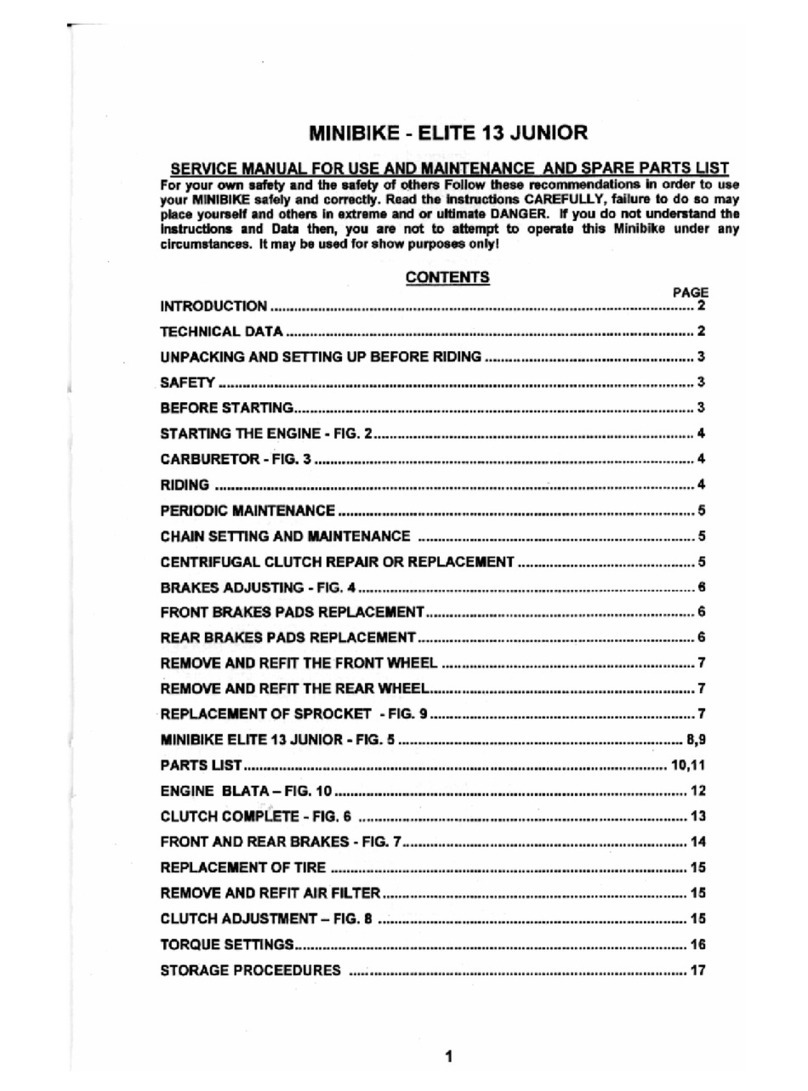
Blata
Blata Minibike Elite 13 Junior User manual
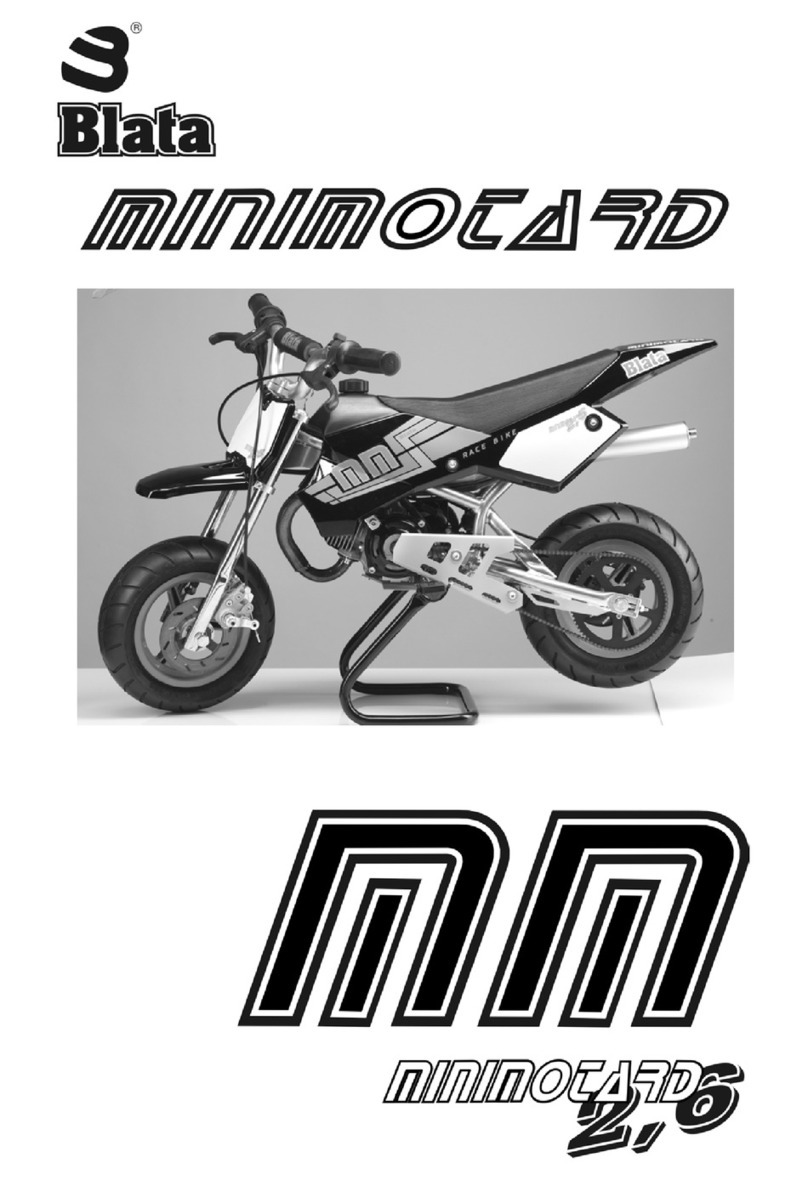
Blata
Blata minimocard 2.6 Instruction manual
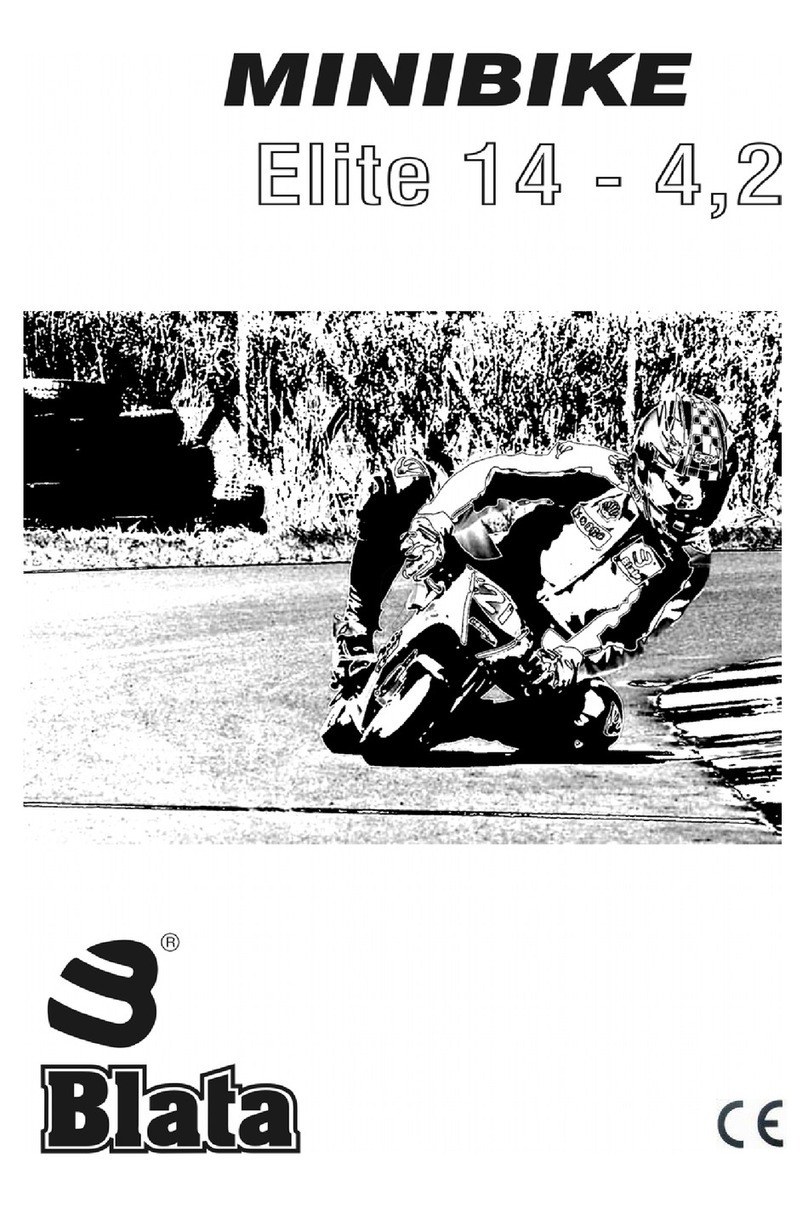
Blata
Blata Elite 14 - 4 User manual

Blata
Blata MOTARD 125 BXM User manual
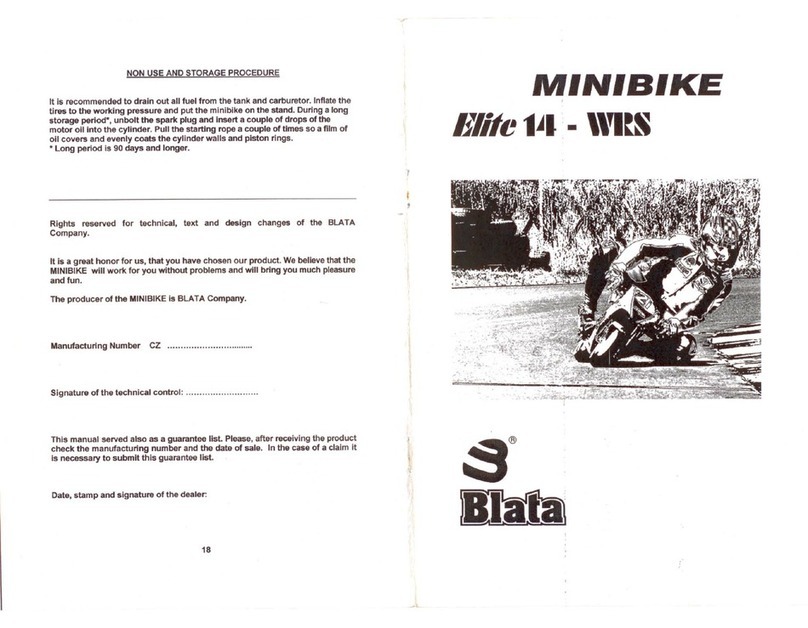
Blata
Blata ELITE 14-WRS User manual
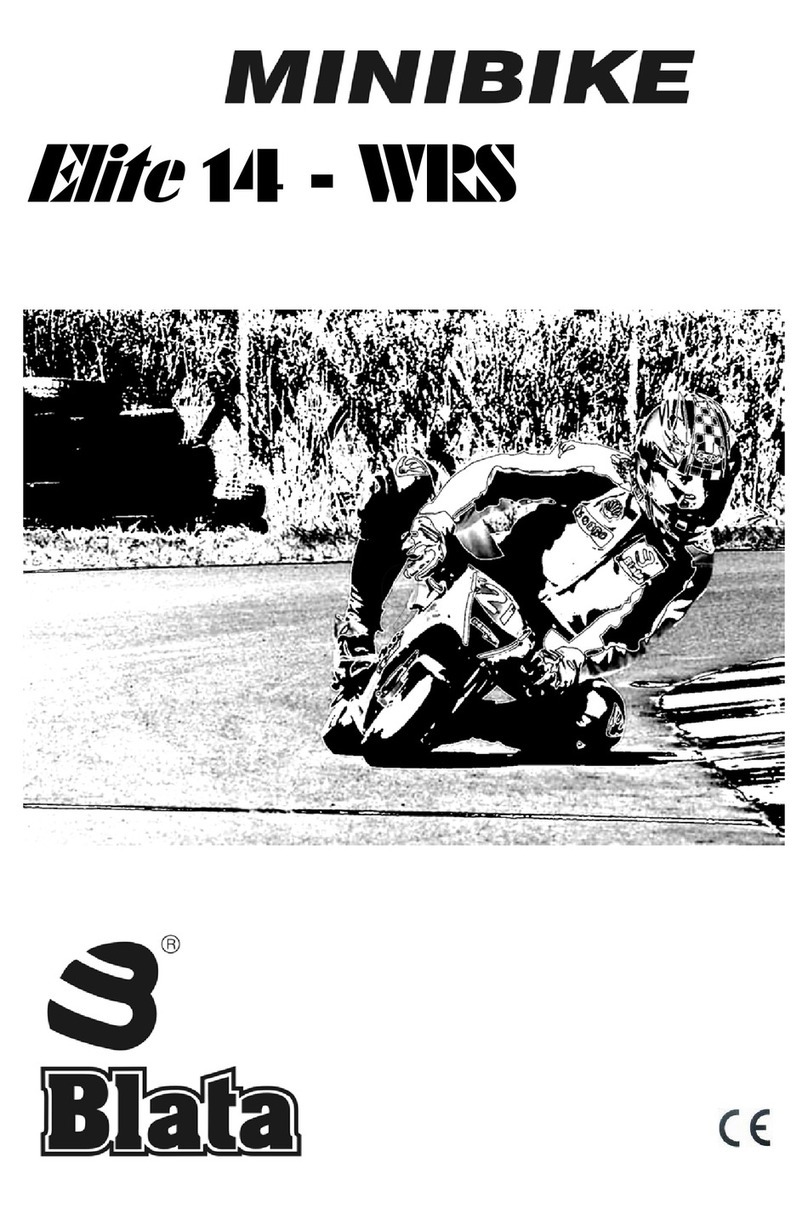
Blata
Blata Minibike Elite 14 WRS User manual
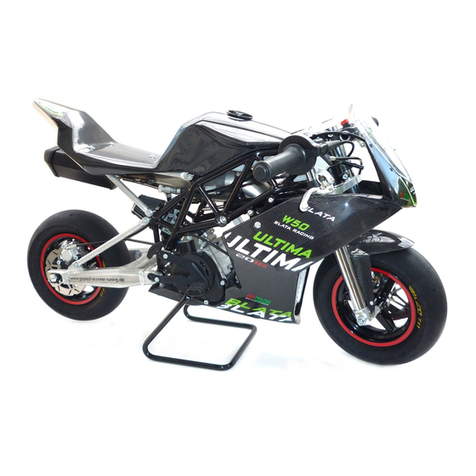
Blata
Blata Ultima User manual

Blata
Blata Origami B1 User manual

Blata
Blata Elite 13 W User manual
